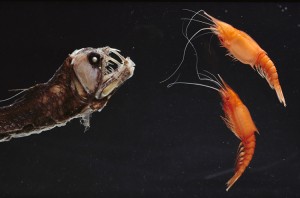Monster Monday: the Viperfish
December 12, 2016
This Monday’s monster, the viperfish, possesses one of the most frightening faces in the sea. Its colossal fangs are too large for its mouth, resting outside the mouth when it is closed. Huge, vacant eyes scan the ocean depths illuminated by its own glowing spine, while its long, skinny body creeps through the water. This frightening creature may resemble a classic sea monster, but it is not large at all, and it is no threat to humans.

The viperfish is a deep-sea fish with long fangs in its mouth. In this photograph, a viperfish stalks shrimplike prey. Credit: © Minden Pictures/Masterfile
The viperfish is a type of deep-sea fish with many long fangs in its mouth. It has a long body with black or silver skin. It can reach 14 inches (35 centimeters) long, though most viperfish are smaller. There are several species (kinds) of viperfish, all of the genus Chauliodus.
The viperfish is found throughout the world’s oceans. Most species live at depths from about 650 to 5,000 feet (200 to 1,500 meters). Some species live at even greater depths, down to more than 15,000 feet (4,600 meters).
Two of the fangs on the lower jaw of the viperfish are especially long. These fangs do not fit inside the mouth when it is closed. Instead, they fit into grooves on the head. The lower jaws of the viperfish open up to 180 degrees. Therefore, the viperfish can eat large prey, up to about a quarter of its size. The ability to eat large prey provides a great advantage in the deep sea. In this region, there is little food, and meals may be infrequent.
Viperfish live so deep in the ocean that the sun’s light is reduced to a faint glimmer, if it is visible at all. Some viperfish species swim toward the surface at night to feed. They return to deeper waters during the day. In the inky waters in which it hunts, the viperfish improves its chances of attracting a meal by producing its own light, an ability called bioluminescence. Its dorsal (back) fin has a light-producing organ at the end of a long spine. Prey animals are attracted to the light, thinking it is either a potential food source or a possible mate. When the animal gets close enough, the viperfish strikes. It will eat just about anything that can fit through its gaping jaws, including smaller fish and shrimp.
In the deep-sea realm, the viperfish is a top predator. Other animals, however, such as swordfish and tuna, dive to great depths to hunt and may consume viperfish. These much larger fish don’t seem to mind the viperfish’s terrifying appearance.


